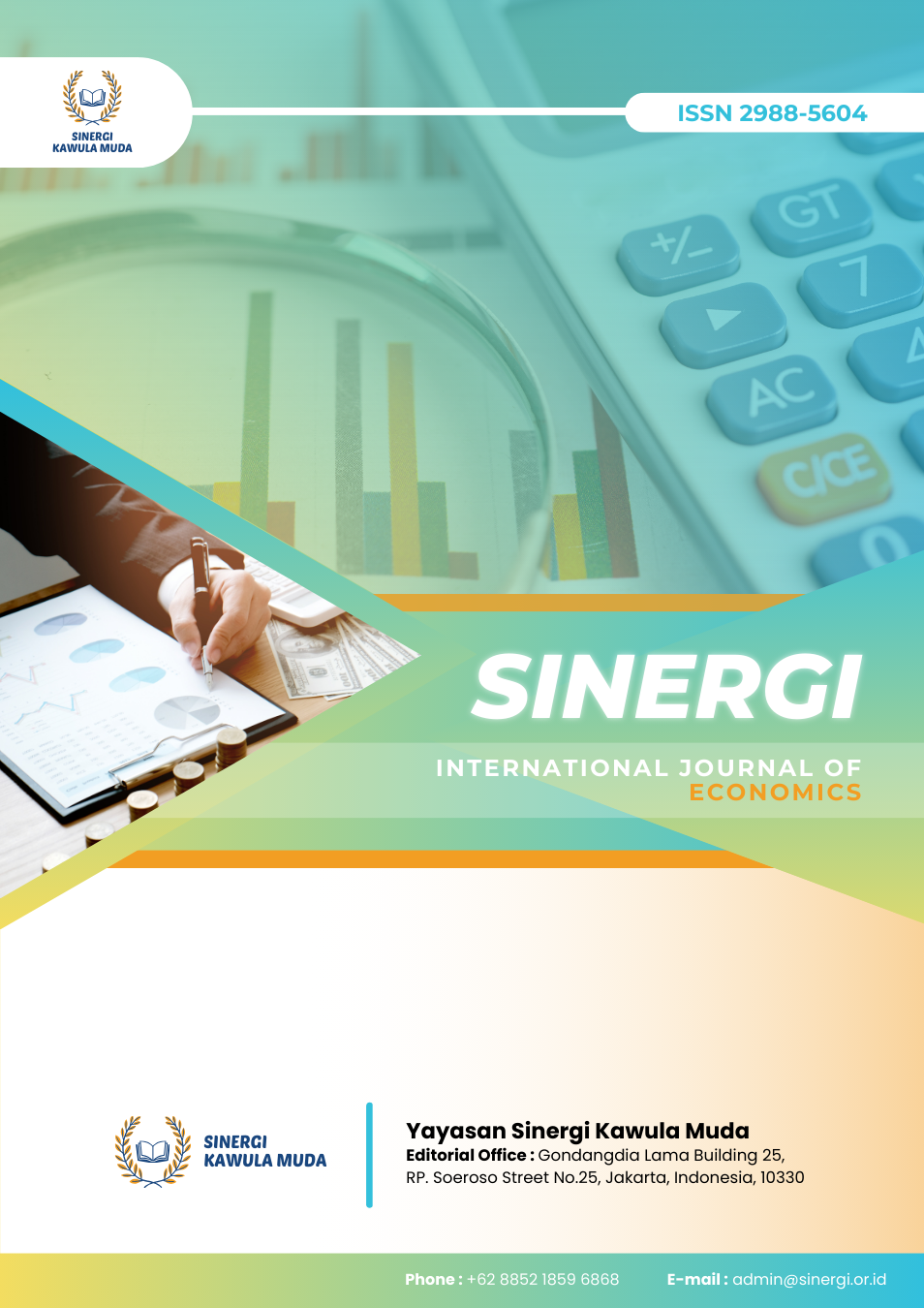Determinants of Output Growth Volatility in Nigeria
DOI:
https://doi.org/10.61194/economics.v3i3.779Keywords:
Growth, Volatility, Autoregressive, Industry, AgricultureAbstract
The paper analysed the impact of agricultural output, investment, population growth and industry growth on output growth volatility. Many researchers have considered the determinants of output growth volatility but the impact of the above-mentioned variables on output growth volatility is scanty in literature. The data were tested for unit roots using Augmented Dickey-Fuller (ADF). Autoregressive Distributed Model (ARDL) was used in the methodology. The short-run dynamic model shows that the above-mentioned variables must undergo substantial structural changes to exert a significant and stabilising effect on output growth volatility in Nigeria. With F statistics of 15.9 and the upper and lower bound of 4.8 and 2.0 respectively, the bounds test result shows that the variables are co-integrated. The paper recommends an export promotion industrial strategy that is accompanied by an import substitution strategy, the re-introduction of a Marketing Board, alongside the construction of irrigation canals in strategically designated agricultural zones, could play a pivotal role in reversing the trend of business and economic instability, thereby helping to curb the persistent volatility in output growth.
References
Abubaker, R. }. (2015). asymmetric impact of trade openness on output volatility}. Empir Econ, 49}, 881–887}. DOI: https://doi.org/10.1007/s00181-014-0899-2
Acemoglu S., Johnson, S., Robinson, J., & Thaicharoen, Y. (2003). Institutional causes, macroeconomic symptoms: volatility, crises and growth}. Journal of Monetary Economics, 50)1}, 49–123}. DOI: https://doi.org/10.1016/S0304-3932(02)00208-8
Alimi, N. }. (2016). Volatility and growth in developing countries; an asymmetric effect}. https://www.academia.edu/113401128} DOI: https://doi.org/10.1016/j.jeca.2016.08.001
Alizadeh M, Brandt, M., & Diebold, F. (2002). Range-based estimation of stochastic volatility models}. https://doi.org/10.1111/1540-6261.00454.} DOI: https://doi.org/10.2139/ssrn.267788
Baker N. and Davis S.J.}, S. R. and B. (2016). Measuring economic policy uncertainty}. The Quarterly Journal of Economics}, 131}(4), 1593–1636}. DOI: https://doi.org/10.1093/qje/qjw024
Bartak A.}, J. and J. and J. (2021). Examining GDP growth and its volatility: an episodic approach}. https://www.ncbi.nlm.nih.gov/pmc/articles/PMC8307840/} DOI: https://doi.org/10.3390/e23070890
Bhoola U.}, F. and K. (2011). Trends and determinants of output growth volatility}. International Journal of Economics and Finance}, 3}(5), 151–160}. DOI: https://doi.org/10.5539/ijef.v3n5p151
Blackburn R.}, K. and G. (2003). Growth, volatility and learning}. Economics Letters}, 78}(3), 417–421}. DOI: https://doi.org/10.1016/S0165-1765(03)00025-9
Blanchard J.}, O. and S. (2001). The long and large decline in U.S. output volatility}. https://muse.jhu.edu/pub/1/journal/52.} DOI: https://doi.org/10.1353/eca.2001.0013
Choudhry F. and Shabi S.}, T. and P. (2016). Stock market volatility and business cycle: Evidence from linear and nonlinear causality tests}. Journal of Banking and Finance, 66}, 89–101}. DOI: https://doi.org/10.1016/j.jbankfin.2016.02.005
Deniz T. and Yazgan M.E.}, P. and S. (2021). Revisiting the link between output growth and volatility: panel GARCH analysis}. Empir Econ, 61}, 743–771}. DOI: https://doi.org/10.1007/s00181-020-01878-4
Dixit S.R.}, A. K. and P. (1994). Investment under uncertainty}. DOI: https://doi.org/10.1515/9781400830176
Ductor D.}, L. and L.-L. (2022). Fluctuations in global output volatility}. https://www.sciencedirect.com/scence/article/pii/s0261560621001844.} DOI: https://doi.org/10.1016/j.jimonfin.2021.102533
Fatas L.}, A. and M. (2005). Policy volatility, institutions and economic growth}. www.cepr.org/pubs/dps/DP5388.asp.}
Fogli F.}, A. and P. (2015). Macroeconomic volatility and external imbalances}. Journal of Monetary Economics, 69}, 1–15}. DOI: https://doi.org/10.1016/j.jmoneco.2014.12.003
Ghosh J.}, A. and O. (1997). Macroeconomic uncertainty, precautionary saving, and the current account}. Journal of Monetary Economics}, 40}(1), 121–139}. DOI: https://doi.org/10.1016/S0304-3932(97)00031-7
Jalles G.}, J. and K. (2023). Macroeconomic volatility and the current account: extending the evidence}. https://doi.org/10.1016/j.econmod.2023.106334.} DOI: https://doi.org/10.1016/j.econmod.2023.106334
Jenny, T. }. (2020). Determinants of growth volatility in low and middle-income countries}. https://digitalcommons.iwu.edu/israel_economics/8.}
Jorda M. and Taylor A.}, O. and S. (2017). Macro financial history and the new business cycle facts}. https://www.journals.uchicago.edu.} DOI: https://doi.org/10.3386/w22743
Kraay J.}, A. and V. (2007). Comparative advantage and the cross-section of business cycles}. Journal of the European Economic Association}, 5}(6), 1300–1333}. DOI: https://doi.org/10.1162/JEEA.2007.5.6.1300
Lucas, E. R. }. (1988). On the mechanism of economic development}. Journal of Monetary Economics}, 22}(1), 3–42}. DOI: https://doi.org/10.1016/0304-3932(88)90168-7
Mensah E.}, I. and M. (2021). The impact of inward FDI on output growth volatility: A country-sector analysis}. Research in Globalization. DOI: https://doi.org/10.1016/j.resglo.2021.100063
Muradov, D. }. (2018). Output growth volatility and inflation uncertainty; empirical evidence from East Asian economies}. https://www.academia.edu/65279663}
Okeowo, I. A. }. (2023). Industrialisation and industrial output nexus in Nigeria: a new empirical evidence}. Journal of Economics and Allied Research}, 8}(3), 123–130}.
Okeowo J.}, I. A. and A. (2024). Money supply exchange rate and output growth volatility in Nigeria}. Journal of Economics and Allied Research}, 9}(3), 27–32}.
Okeowo M.P.}, I. A. and R. (2023). Unemployment and inflation trade-off; the Nigerian experience in the context of Philip curve}. Journal of Economics and Allied Research}, 8}(2), 109–119}.
Ramey V.A.}, G. and R. (1995). evidence on the link between volatility and growth}. American Economic Review}, 85}(5), 1138–1151}.
Romer, M. P. }. (1990). Endogenous technical change}. Journal of Political Economy}, 98}(5), 71–102}. DOI: https://doi.org/10.1086/261725
Zagler, M. }. (2017). Empirical evidence on growth and business cycles}. Empirical, 44}, 547–560}. DOI: https://doi.org/10.1007/s10663-016-9336-4






